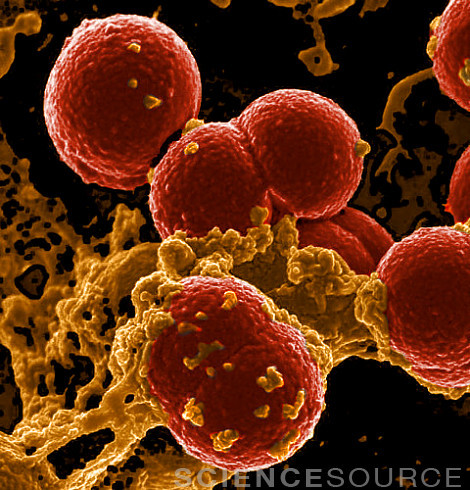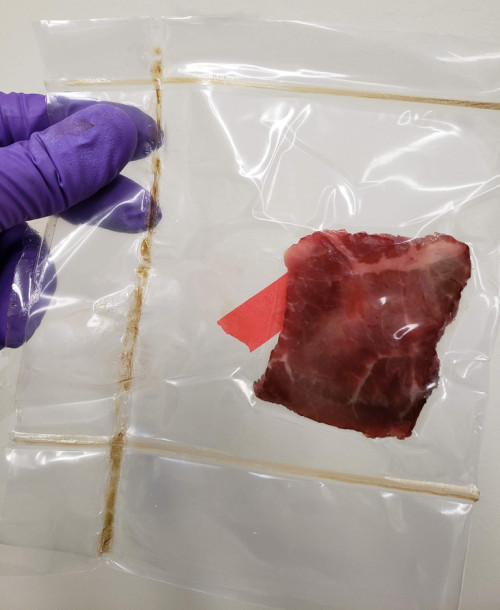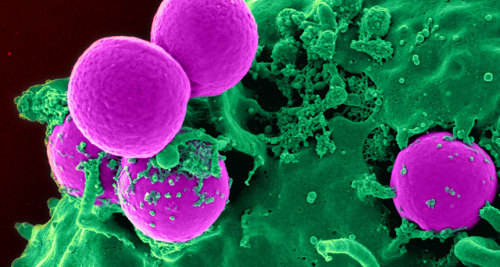#staphylococcus aureus
Image JC3202 (Neutrophil Ingesting MRSA Bacteria)
Colorized scanning electron micrograph of Neutrophil white blood cells (light orange) ingesting Methicillin-Resistant Staphylococcus Aureus bacteria (deep red).
Methicillin-Resistant Staphylococcus Aureus (MRSA), also called multidrug-resistant staphylococcus aureus and oxacillin-resistant staphylococcus aureus (ORSA). This bacterium is responsible for several difficult-to-treat infections in humans.
MRSA is any strain of Staphylococcus aureus that has developed resistance to beta-lactam antibiotics, like penicillins and cephalosporins. Strains unable to resist these antibiotics are classified as methicillin-sensitive Staphylococcus aureus, or MSSA.
MRSA is especially troublesome in hospitals and nursing homes, where patients with open wounds, invasive devices, and weakened immune systems are at greater risk of infection than the general public. If not treated quickly, MRSA infections can cause sepsis and death.
It is usually spread by direct contact with an infected wound or from contaminated hands, usually those of healthcare providers. Also, people who carry MRSA but do not have signs of infection can spread the bacteria to others.
The only way to know if MRSA is the cause of an infection is to perform a laboratory culture of the bacteria. Obtaining bacteria to culture is a procedure done by a doctor or nurse.
© NIAID / Science Source
Post link
Novel composite antimicrobial film could take a bite out of foodborne illnesses
A novel composite film — created by the bonding of an antimicrobial layer to conventional, clear polyethylene plastic typically used to vacuum-package foods such as meat and fish — could help to decrease foodborne illness outbreaks, according to researchers in Penn State’s College of Agricultural Sciences.
Raw beef (shown here), raw chicken breast and ready-to-eat turkey breast were inoculated with pathogens then vacuum packaged with the composite antimicrobial film, sealed and placed into refrigerated storage. The composite antimicrobial film significantly reduced foodborne pathogens on the experimentally inoculated surfaces of the raw and ready-to-eat muscle foods.

The novel composite antimicrobial film stopped pathogens from growing on this ready-to-eat turkey breast.
Learn more at Penn State News.
Post link
An unlikely superhero may have been identified in the fight against superbug MRSA–– the human nose! Noses often contain Staphylococcus aureus, but apparently also contain a compound that acts as a natural enemy of MRSA (the methicillin-resistant strain of S. aureus.)
Scientists at University of Tübingen in Germany isolated this nasal bacterium, S. lugdunensis, and discovered that it destroyed S. aureus in a petri dish when grown together.
From ScienceNews.org: “We didn’t expect to find this. We were just trying to understand the ecology of the nose to understand how S. aureus causes problems,” bacteriologist Andreas Peschel of the University of Tübingen in Germany said at a news briefing July 26 during the EuroScience Open Forum. Investigating the intense interspecies competition in the nose — where microbes fight for space and access to scant sugars and amino acids — might offer a fertile alternative to searching for new drug candidates in soil microbes.”
Learn more about this study and the possible antibiotic implications in the article “The nose knows how to fight staph” at ScienceNews.org, or read the study “Human commensals producing a novel antibiotic impair pathogen colonization” at Nature.
Post link



